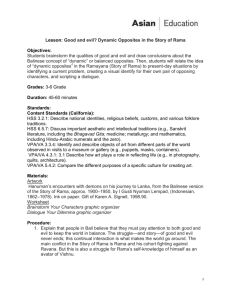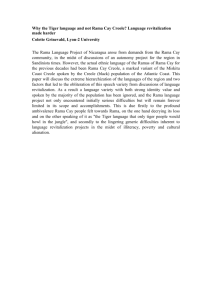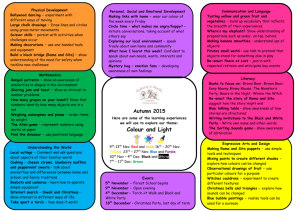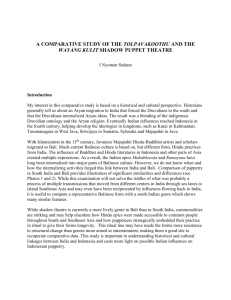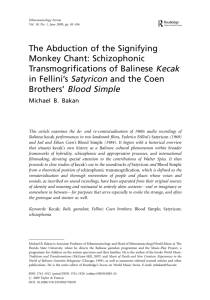STORIES THEN AND NOW - Asian Art Museum | Education
advertisement
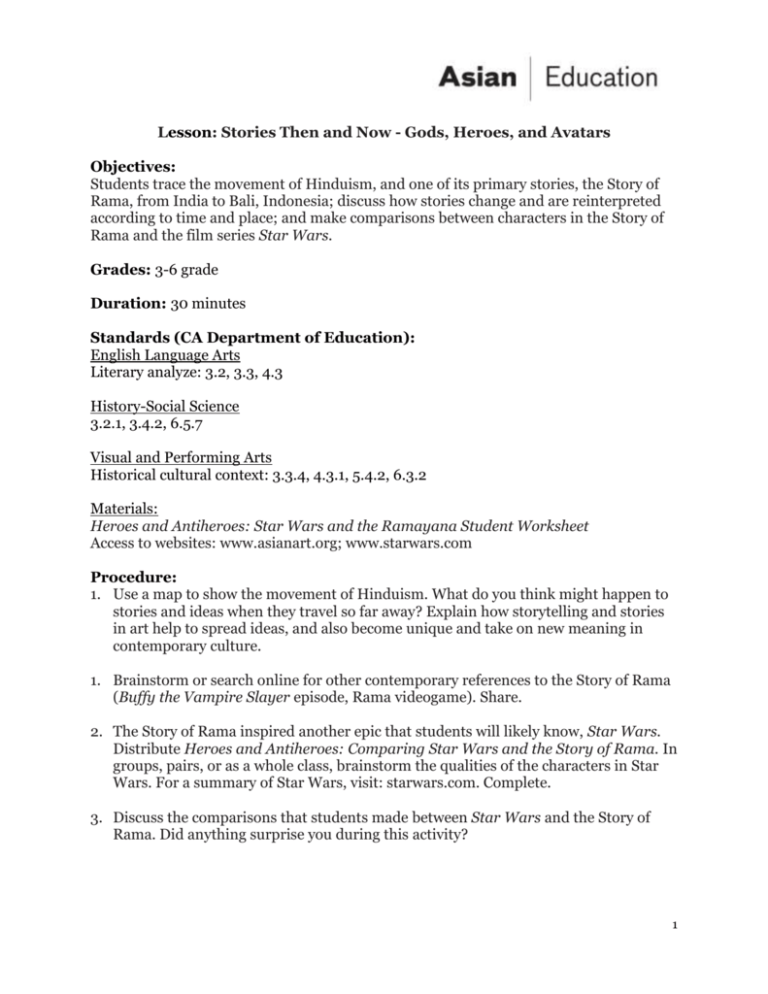
Lesson: Stories Then and Now - Gods, Heroes, and Avatars Objectives: Students trace the movement of Hinduism, and one of its primary stories, the Story of Rama, from India to Bali, Indonesia; discuss how stories change and are reinterpreted according to time and place; and make comparisons between characters in the Story of Rama and the film series Star Wars. Grades: 3-6 grade Duration: 30 minutes Standards (CA Department of Education): English Language Arts Literary analyze: 3.2, 3.3, 4.3 History-Social Science 3.2.1, 3.4.2, 6.5.7 Visual and Performing Arts Historical cultural context: 3.3.4, 4.3.1, 5.4.2, 6.3.2 Materials: Heroes and Antiheroes: Star Wars and the Ramayana Student Worksheet Access to websites: www.asianart.org; www.starwars.com Procedure: 1. Use a map to show the movement of Hinduism. What do you think might happen to stories and ideas when they travel so far away? Explain how storytelling and stories in art help to spread ideas, and also become unique and take on new meaning in contemporary culture. 1. Brainstorm or search online for other contemporary references to the Story of Rama (Buffy the Vampire Slayer episode, Rama videogame). Share. 2. The Story of Rama inspired another epic that students will likely know, Star Wars. Distribute Heroes and Antiheroes: Comparing Star Wars and the Story of Rama. In groups, pairs, or as a whole class, brainstorm the qualities of the characters in Star Wars. For a summary of Star Wars, visit: starwars.com. Complete. 3. Discuss the comparisons that students made between Star Wars and the Story of Rama. Did anything surprise you during this activity? 1 Further Research: Translations: Goldman, Robert P. The Ramayana of Valmiki, Princeton Library of Asian Translations. Princeton: Princeton University Press, 1990. For Students: Clevaland Beech, Milo. The Adventures of Rama: With illustrations from a 16th Century Mughal Manuscript. Washington, DC: Smithsonian Books, 1983, forthcoming reprint by Mapin Publishing, 2011. Cox, David. Ayu and the Perfect Moon. London: Bodley Head Children’s Books, 1984. Mason, Victor, with Gillian Beal. Balinese Children’s Favorite Stories. North Clarendon: Tuttle Publishing, Periplus Editions, 2001. Weitzman, David. Rama and Sita: A Tale of Ancient Java. Boston: David Godine, 2002. For Teachers: Burton, Richard T. Hindu Art. London: British Museum Press, 1992. Dibia, Wayan, and Rucina Ballinger. Balinese Dance, Drama, and Music: A Guide to the Performing Arts of Bali. North Clarendon: Tuttle Publishing, Periplus Editions, 2004. Dibia, I Wayan. Kecak: The Vocal Chant of Bali. Denpasar: Hartano Art Books, Bali.1996. Eiseman, Fred. Sekala and Niskala, Volumes I and II. North Clarendon: Tuttle Publishing, Periplus Editions, 1989. Kam, Garrett. Story of Rama in the Arts of Asia. Singapore: Select Books, 2000. Richman, Paula, ed. Many Story of Ramas: The Diversity of a Narrative Tradition in South Asia. Berkeley: University of California Press, 1991. Richter, Anne. Arts and Crafts of Indonesia. London: Thames & Hudson, 1993. Tenzer, Michael. Balinese Music. North Clarendon: Tuttle Publishing, Periplus Editions, 1991. Local Organizations Gamelan Sekar Jaya, www.gsj.org: A Bay Area music and dance group specializing in Balinese music; the sixty-member group performs, gives workshops and classes, and hosts master guest artists from Bali. ShadowLight Productions, www.shadowlight.org: A San Francisco-based theater company that integrates Balinese forms of shadow puppetry and storytelling with modern production techniques. Larry Reed, artistic director, is a shadow puppeteer who translates Balinese puppetry for English-speaking audiences. (His film Shadow Master is recommended for ages 8 and up.) KQED Spark has an educators guide on ShadowLight. http://www.shadowlight.org/slp/docs/Spark-EducatorGuide.pdf Online Resources Office of Resources for International and Area Studies (ORIAS), University of California, Berkeley, orias.berkeley.edu: “The Story of Rama in Southeast Asia.”. 2 Kecak performance of the Story of Rama, www.youtube.com/watch?v=CX1rghsOqu0&feature=fvw Gamelan Sekar Jaya’s I Putu Putrawan and Wayne Vitale playing interlocking gamelan patterns from the piece Teruna Jaya: www.youtube.com/watch?v=7y771-AxrFA Interlocking drumming pattern: www.youtube.com/watch?v=wlY2DiwEghQ&NR=1 Center for Southeast Asian Studies, Northern Illinois University, www.seasite.niu.edu: Summary of the Indonesian Story of Rama, audio files in Indonesian, and Javanese temple reliefs. Performance of interlocking parts by Balinese musician I Putu Putrawan and Wayne Vitale, http://www.youtube.com/watch?v=7y771-AxrFA. 3
